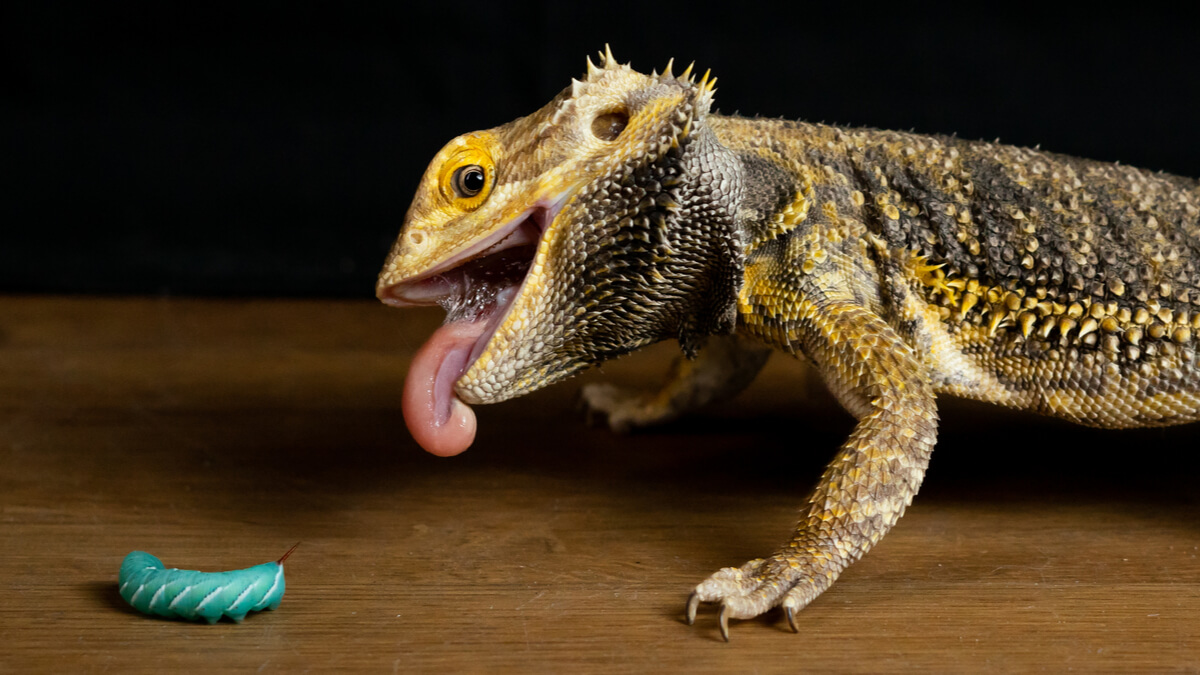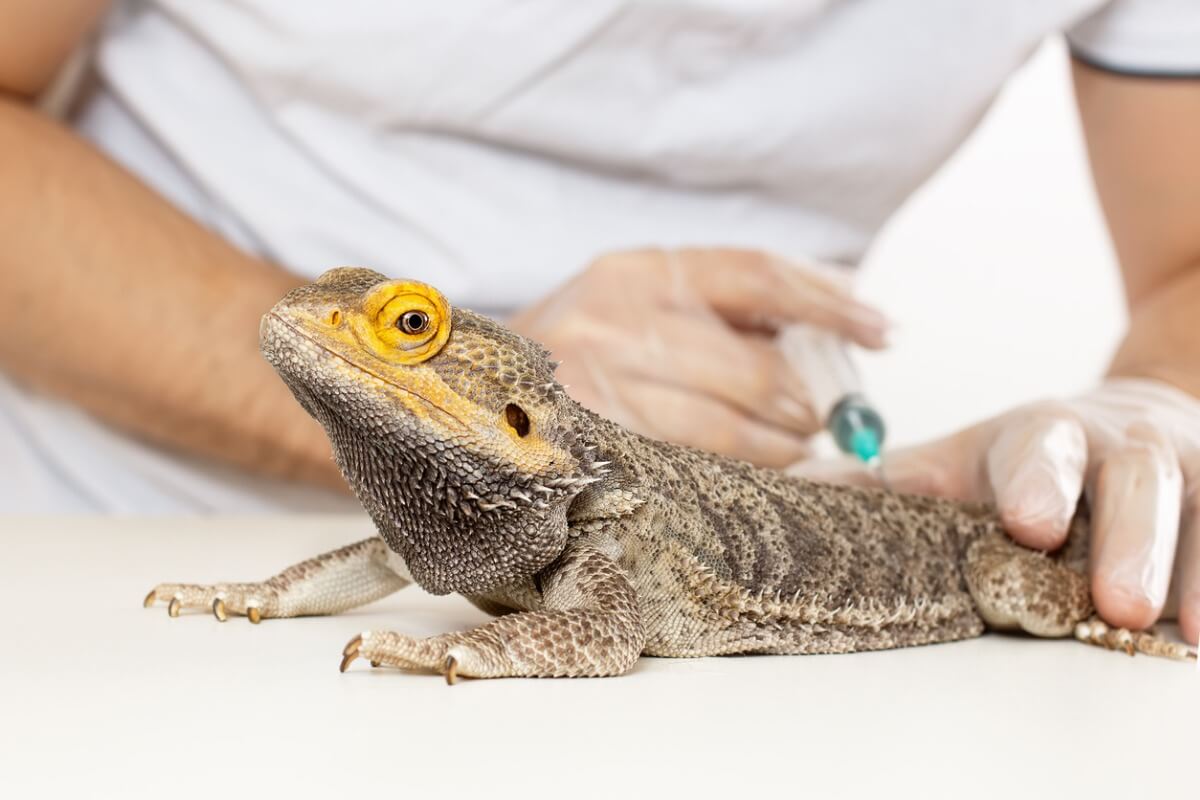The 11 Most Common Diseases in Bearded Dragons


Written and verified by the biologist Cesar Paul Gonzalez Gonzalez
The pogona lizard, or bearded dragon (Pogona vitticeps) is usually quite docile, social, and easy to keep in captivity. This has led it to become a very popular pet among reptile enthusiasts. However, you need to be careful with their health, as bearded dragons can be susceptible to different diseases. Find out about the most common diseases in bearded dragons in this article.
This reptile has great resistance to adverse conditions in their habitat, although this doesn’t make it immune to all illnesses. For this reason, proper care must be maintained to keep your pet healthy. Read on and learn about the 11 most common diseases in bearded dragons.
Factors that cause diseases in bearded dragons
Most of the diseases in captive reptiles are caused by the carelessness of their owners. Therefore, you’ll need to pay attention to the needs of the pet to avoid problems that can be fatal. Some of the points to consider are as follows:
- Habitat conditions: Reptiles depend on the conditions of their environment to activate their metabolism, so any changes could produce serious consequences in their health. Temperature, humidity, and lighting are what have the most impact on the pet.
- Diet: The diet of omnivorous animals is usually one of the most complicated to maintain, as they need a wide variety of foods. This factor is very important, as proper nutrition keeps the animal’s body vigorous and allows it to cope with illnesses. There are also a wide variety of nutritional problems that can cost a reptile its life.
- Hygiene: As time goes by, dirt accumulates in the habitat, which leads to the appearance of dangerous sources of infection for the reptile. A proper cleaning regime is necessary to avoid this. In addition, owners should remember to wash their hands before and after handling the pet to prevent the spread of other diseases.
- Accidents: Any physical injury suffered by the reptile can lead to serious illness, so it’s best to attend to it promptly and properly.

What are the most common diseases in bearded dragons?
The terrariums bearded dragons live in are ideal places for the proliferation of pathogens. Therefore, if the reptile is weak due to a lack of care, it’ll be easy for it to develop an illness that could threaten its life. Below is a list of the most common diseases in bearded dragons.
1. Metabolic bone disease
Metabolic bone disease is a condition that affects several types of domestic reptiles. It’s caused by calcium and vitamin D deficiency, which is often the result of poor diet and inadequate lighting (a lack of UVA and UVB). As a result, the pet’s metabolism begins to demineralize the bones and makes them more fragile.
Treatment consists of giving the pet food supplements, which solves the problem in a very short time. However, the most severe conditions leave the animals with spinal deformities that are disabling. Only a veterinarian will be able to give you the options available in each situation.
2. Hepatic lipidosis
Hepatic lipidosis is caused by the consumption of excess fats. This is due to a poorly balanced diet or overfeeding. As a result, fatty acids are stored in the liver and cause imbalances in the animal’s metabolism. The most common clinical signs are weight loss, lethargy, and pale internal mucous membranes.
Treatment of this condition involves changes to the animal’s diet in order to regulate fat intake and stop it from accumulating in the liver. However, it’s also possible that a different disease is causing the lipidosis, which is usually ruled out with a thorough clinical examination.
3. Hypovitaminosis (vitamin B1 deficiency)
Vitamin B1 (thiamine) plays an essential role in the body, helping to provide energy to all of the reptile’s cells. For this reason, a deficiency of this substance causes paralysis, weakness and spasms. In the case of bearded dragons, thiamine deficiency may be due to a diet that doesn’t contain fresh vegetables.
4. Dysecdysis
Dysecdysis refers to any problem that reptiles have during their molt. These cases are usually caused by low humidity in the environment, but some parasitosis and other ailments are also involved. The most affected areas are the toes, tail, and legs.
Dead skin causes a tourniquet effect, which impedes blood circulation. As a result, the limbs atrophy and are eventually lost. The most obvious signs of dysecdysis are opaque or whitish patches of skin.
5. Stomatitis
Stomatitis is the term used to describe an inflammation of the mouth, which can be due to several different pathogens. In bearded dragons, this is usually caused by bacteria that take advantage of the susceptibility of their teeth. This is because the dental structure of these animals is quite fragile and predisposes them to infection.
6. Mites
Ectoparasites such as mites are also common on reptile skin. In fact, there are three different mites that can invade bearded dragons and settle in the folds of their skin. The problem with this parasitosis is its persistence, because, without proper treatment, it’s difficult to eliminate them completely.
In addition, we recommend that you constantly clean the habitat of the sick bearded dragon to avoid future infections.
7. Yellow fungus disease
This disease is caused by a pathogenic fungus that invades the skin of bearded dragons. As a result, it causes a very obvious yellow dermatitis that spreads as the infection progresses. This pathology can be lethal if left to fester, as it also affects internal organs and causes multi-systemic failure.
Diagnosis requires a professional to check the lesions and confirm the presence of the fungus. As for treatment, only a veterinarian can suggest the appropriate antifungal and medication to control the condition. However, keep in mind that there are still no effective drugs that can cure the disease.
8. Virus infection (adenovirus)
Adenoviruses are a group of pathogens that can cause several different problems in bearded dragons. In general, most of the symptoms are associated with the digestive system, so affected pets fail to grow much and show weight loss. The most vulnerable animals are the young and newborns, but there are also some cases in adults.
Infection can be detected by various medical tests, although new generation tests (such as PCR) are somewhat more efficient. However, there’s currently no effective treatment for adenoviruses.
9. Intestinal infections (pinworms and coccidia)
Intestinal parasites are often common in animals that are fed unsanitized vegetables. Endoparasites (such as coccidia and pinworms) affect the pet’s intestine and are the most common in this area. General symptoms are lethargy, diarrhea and weight loss. In severe pinworm infestations, intestinal impaction can occur.
10. Intestinal impaction
Bearded dragons often accidentally consume some of their substrate, causing it to enter their digestive system and cause some problems. It’s important to choose this aspect of the habitat well. Otherwise, substrates such as sand, gravel or sawdust can clump in the animal’s intestine and cause impaction (obstruction).
11. Respiratory infections
The reptile habitat houses ideal conditions for a variety of bacteria and viruses to thrive. Consequently, microorganisms such as bacteria thrive without proper cleaning. To make matters worse, humidity allows these agents to become suspended in the air and can enter the lungs of the pet, which causes respiratory pathologies.
To avoid this, it’s necessary to have excellent ventilation in the terrarium. This will prevent the air from becoming too dense, and prevent bacteria from having the right conditions to grow. Remember that it’s also crucial to maintain the cleanliness of the area, as feces and food waste are sources of infection that promote this pathology.

Most of the pathologies in reptiles can be avoided with good maintenance of the terrarium. Take into account all the basic needs of your bearded dragon, otherwise you’ll have to deal with their illnesses and diseases. If there are any changes in the behavior or physique of your pet, then go to the vet. It never hurts to have a preventive check-up.
All cited sources were thoroughly reviewed by our team to ensure their quality, reliability, currency, and validity. The bibliography of this article was considered reliable and of academic or scientific accuracy.
- Schmidt-Ukaj, S., Hochleithner, M., Richter, B., Hochleithner, C., Brandstetter, D., & Knotek, Z. (2017). A survey of diseases in captive bearded dragons: a retrospective study of 529 patients. Veterinární medicína, 62(9), 508-515.
- Raiti, P. (2012). Husbandry, diseases, and veterinary care of the bearded dragon (Pogona vitticeps). Journal of Herpetological Medicine and Surgery, 22(3-4), 117-131.
- Benato, L. (2010). Managing stomatitis in pet reptiles. Vet Times (Peterb), 2, 1-4.
- Boyer, T. H. (2015). Diseases of bearded dragons. In Proceedings of the Pacific Veterinary Conference (pp. 1-6).
- Barboza, T. (2021). Hepatic Lipidosis in the Bearded Dragon (Pogona vitticeps): Diagnostic and Therapeutic Investigations (Doctoral dissertation).
- Abarca, M. L., Martorell, J., Castellá, G., Ramis, A., & Cabañes, F. J. (2009). Dermatomycosis in a pet inland bearded dragon (Pogona vitticeps) caused by a Chrysosporium species related to Nannizziopsis vriesii. Veterinary dermatology, 20(4), 295-299.
This text is provided for informational purposes only and does not replace consultation with a professional. If in doubt, consult your specialist.